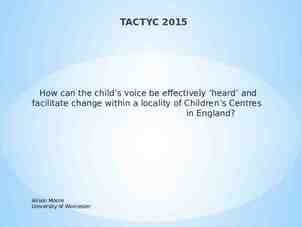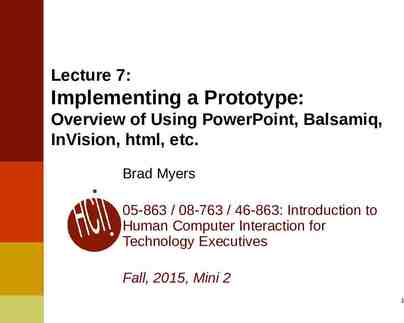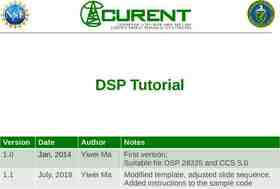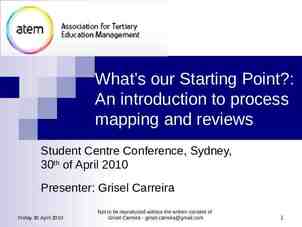Introduction to the Clinical Document Architecture For the HL7
68 Slides3.66 MB
Introduction to the Clinical Document Architecture For the HL7 Child Health Work Group Gay Giannone MSN, RN June 10, 2009 www.alschulerassociates.com
Instructor Gay Giannone MSN, RN – [email protected] 2 Alschuler Associates, LLC, 2009 – 20 years Neonatal Intensive Care Experience – Masters in Nursing Administration and Healthcare Informatics University of Pennsylvania -2004 – Member HL7 SDWG – CDA certified – Primary editor on CDA Implementation Guides: QRDA Public Health Case Report Operative Note
Basic understanding of CDA Understand relationship between CDA, CCD, CRS Opportunities for pediatric work in HL7 3 Alschuler Associates, LLC, 2009 Objectives
Part 1 - Outline Overview of CDA Definition XML. and more Usage Let’s take a look. The “A” in CDA The Specification Implementation Current Work, Summary & Resources 4 Alschuler Associates, LLC, 2009 – – – –
CDA History Clinical Document Architecture ANSI/HL7 CDA R1.0-2000 ANSI/HL7 CDA R2.0-2005 Created & maintained by HL7 Structured Documents Work Group (SDWG) A specification for document exchange using – – – – XML, the HL7 Reference Information Model (RIM) Version 3 methodology and vocabulary (SNOMED, ICD, local, ) 5 Alschuler Associates, LLC, 2009
CDA: A Document Exchange Specification Alschuler Associates, LLC, 2009 This is a CDA and this and this and this and this and this and this 6 6
CDA: What is a document? – reflect historical form of healthcare record – mix discrete data and free-flowing narrative CDA restricts the set of healthcare documents 7 Alschuler Associates, LLC, 2009 In XML-speak, everything is a “document” Intuitively, documents:
The CDA document defined A clinical document . has the following characteristics: Persistence Stewardship Potential for authentication Context Wholeness Human readability therefore, CDA documents are not: – data fragments, unless signed – birth-to-death aggregate records – electronic health records 8 Alschuler Associates, LLC, 2009 CDA Release 2, section 2.1: 8
priority is patient care, other applications facilitated minimize technical barriers to implementation promote longevity of clinical records scoped by exchange, independent of transfer or storage enable policy-makers to control information requirements 9 Alschuler Associates, LLC, 2009 CDA Design Principles
Investing in Information – like charging a battery, – the more detailed the encoding – the greater the potential for reuse 10 Alschuler Associates, LLC, 2009 CDA can be simple CDA can be complex Simple encoding relatively inexpensive Complex encoding costs more You get what you pay for:
Outline Overview of CDA Definition XML. and more Usage Let’s take a look. The “A” in CDA The Specification Implementation Current Work, Summary & Resources 11 Alschuler Associates, LLC, 2009 – – – –
CDA: XML Alschuler Associates, LLC, 2009 XML is Extensible Markup Language (www.w3c.org) In XML, structure & format are conveyed by markup which is embedded into the information 12 12
and why XML alone isn’t enough With a few simple tags, and controlled vocabulary, XML can describe anything but the tags need to be defined: CDA tags are defined by the HL7 Reference Information Model (RIM) and use standard controlled vocabulary 13 Alschuler Associates, LLC, 2009 orderNum : HL7: order placed orderNum : CDISC: visit sequence
“hives”: SNOMED CT 247472004 “Dr. Dolin asserts that Henry Levin manifests hives as a previously-diagnosed allergic reaction to penicillin” 14 Alschuler Associates, LLC, 2009 Why isn’t XML SNOMED enough?
First: human readable !-- Alschuler Associates, LLC, 2009 ******************************************************** Allergies & Adverse Reactions section ******************************************************** -- component section code code "10155-0" codeSystem "2.16.840.1.113883.6.1" codeSystemName "LOI NC" / title Allergies and Adverse Reactions / title text list item Penicillin - Hives / item item Aspirin - Wheezing /item item Codeine - I tching and nausea / item / list / text 15
Next: series of coded “clinical statements” Observation: RIM-defined History: SNOMED Hives: SNOMED Observation: RIM-defined History : SNOMED Allergy to penicillin: SNOMED Relationship: RIM-defined RIM-defined CDA structures vocabulary Hives manifests an allergic reaction to penicillin entry observation classCode "OBS" moodCode "EVN" code code "84100007" codeSystem "2.16.840.1.113883.6.96" codeSystemName "SNOMED CT" displayName "history taking (procedure) " / value xsi:type "CD" code "247472004" codeSystem "2.16.840.1.113883.6.96" codeSystemName "SNOMED CT" displayName "Hives" / entryRelationship typeCode "MFST" observation classCode "OBS" moodCode "EVN" code code "84100007" codeSystem "2.16.840.1.113883.6.96" codeSystemName "SNOMED CT" displayName "history taking (procedure) " / value xsi:type "CD" code "91936005" codeSystem "2.16.840.1.113883.6.96" codeSystemName "SNOMED CT" displayName "Allergy to penicillin" / / observation 2006 Health Level Seven , Inc. All Rights Reserved. HL7 / entryRelationship and Health Level Seven are registered trademarks of Health / observation Level Seven, Inc. Reg. U.S. Pat & TM Off / entry
!-- Then: supply context Alschuler Associates, LLC, 2009 ******************************************************** CDA Header ******************************************************** -- id extension "c266" root "2.16.840.1.113883.3.933" / code code "11488-4" codeSystem "2.16.840.1.113883.6.1" displayName "Consultation note" / title Good Health Clinic Consultation Note / title effectiveTime value "20000407" / confidentialityCode code "N" codeSystem "2.16.840.1.113883.5.25" / setI d extension "BB35" root "2.16.840.1.113883.3.933" / versionNumber value "2" / legalAuthenticator Who is the subject? author custodian Target: RIM-defined recordTarget patient id extension "12345" root "2.16.840.1.113883.3.933" / Id: local patientPatient name given Henry / given family Levin / family suffix the 7th / suffix / name administrativeGenderCode code "M" codeSystem "2.16.840.1.113883.5.1" / birthTime value "19320924" / / patientPatient providerOrganization id extension "M345" root "2.16.840.1.113883.3.933" / / providerOrganization / patient 17 / recordTarget
CDA complements HL7 messaging specs A CDA document is a defined and complete information object that can exist outside of a messaging context A CDA document can be a MIMEencoded payload within an HL7 message 18 Alschuler Associates, LLC, 2009 Relationship to HL7 messages
Relationship to HL7 messages CDA documents are encapsulated as MIME packages within HL7 messages MSH . EVN . PID . PV1 . TXA . OBX 1 ED . . someMessage Act.Code code "11488-4“ codeSystem "2.16.840.1.113883." displayName "Consultation note"/ Act.text type "multipart/related" MIME-Version: 1.0 Content-Type: multipart/related; boundary "HL7-CDAboundary"; type "text/xml"; start "10.12.45567.43" Content-Transfer-Encoding: BASE64 --HL7-CDA-boundary Content-Type: text/xml; charset "US-ASCII“ Content-ID: <10.12.45567.43 . Base 64 of base CDA document, which contains . observationMedia classCode "OBS" moodcode "EVN" id root "10.23.4567.345"/ value mediaType "image/jpeg" reference value "left hand image.jpeg"/ /value /observationMedia . --HL7-CDA-boundary Content-ID: <10.23.4567.345 Content-Location: canned left hand image.jpeg Content-Type: image/JPEG . Base64 image . --HL7-CDA-boundary- /Act.text 19 /someMessage Alschuler Associates, LLC, 2009 HL7 V2.x HL7 V3
Primary Use Cases access/portability/exchange – query/locate by patient, provider, practitioner, setting, encounter, date – access distributed information through common metadata – document management – transcription systems – EHR records re-use/derivative data – summaries, reports – decision support 20 Alschuler Associates, LLC, 2009 integration
Outline Overview of CDA Definition XML. and more Usage Let’s take a look. The “A” in CDA The Specification Implementation Current Work, Summary & Resources 21 Alschuler Associates, LLC, 2009 – – – –
CDA header body CDA Header – Metadata required for document discovery, management, retrieval CDA Body Discharge Summary Care Record Summary Progress Note H&P Public health report – any content that carries a signature 22 Alschuler Associates, LLC, 2009 – Clinical report
CDA Header: Metadata Identify – Patient – Provider – Document type. Sufficient for – – – – – Medical records management Document management Registry/repository Record locator service Store, query, retrieve 23 Alschuler Associates, LLC, 2009 required
CDA Specification is generic – Any document type – Any clinical content Simplest body: non-XML XML body Defines legal content Displays with simple style sheet Required – Machine-readable “clinical statements” Drives automated extraction, decision support . Uses HL7 RIM, controlled vocabulary Optional 24 Alschuler Associates, LLC, 2009 – Human-readable “narrative block”
CDA Body: Human-readable report Any type of clinical document – – – – H&P Consult Op note Discharge Summary. Format: tif, PDF, HTML, XML: Paragraph List Table Caption Link Content Presentation Alschuler Associates, LLC, 2009 – – – – – – – required 25
Alschuler Associates, LLC, 2009 Non-XML CDA Body 26
CDA Body: Machine Processible – Model-based computable semantics: 27 Optional Alschuler Associates, LLC, 2009 Observation Procedure Organizer Supply Encounter Substance Administration Observation Media Region Of Interest Act
CDA: Incremental Semantic Interoperability Standard HL7 metadata Simple XML for point of care human readability Alschuler Associates, LLC, 2009 RIM semantics for reusable computability (“semantic interoperability”) 28
Outline Overview of CDA The “A” in CDA Levels Scalability: simple to complex The Specification Implementation Current Work, Summary & Resources 29 Alschuler Associates, LLC, 2009 – –
The CDA Architecture What is the unit of standardization? – data element: too narrow – longitudinal record: too broad – document: just right – can’t put everything into a single spec – how to coordinate multiple specs? CDA architecture: – generic pattern with rigorous metadata – specialize/constrain clinical body per document type 30 Alschuler Associates, LLC, 2009 One document standard or many?
Outline Overview of CDA The “A” in CDA Levels Scalability: simple to complex The Specification Implementation Current Work, Summary & Resources 31 Alschuler Associates, LLC, 2009 – –
CDA Levels Levels are distinguished by: granularity of machine-processible markup Level One -- Body is human-readable, no semantic codes. – Level Two -- Instances with machine-processible sectionlevel semantics. All levels validate against the generic CDA schema. Additional validation can be provided by templates and constraints on the generic schema. 32 Alschuler Associates, LLC, 2009 – Level Three -- Instances that have at least some clinical statements, expressions that are machine-processible to the extent that can be modeled in the RIM.
Release 2: Levels One, Two, Three Section code code "10153-2" codeSystem "LOINC“ Past Medical History /code Level 2 human readable text list item content Asthma /content /item item content Hypertension /content /item item content ID “a3” Osteoarthritis, right knee /content /item /list /text Level 1 component1 contextConductionInd value "TRUE"/ Observation classCode “COND” code code ”G-1001” codeSystem ”SNOMED” displayName ”Prior dx”/ value code ”D1-201A8” codeSystem ”SNOMED” displayName ”Osteoarthritis” originalText reference value ”#a3”/ /originalText /value targetSiteCode code ”T-15720” codeSystem ”SNOMED” displayName ”Knee joint” qualifier name code ”G-C220” codeSystem ”SNOMED” displayName ”with laterality”/ value code ”G-A100” codeSystem ”SNOMED” displayName ”right”/ /qualifier originalText reference value ”#a4”/ /originalText /targetSiteCode /Observation /component1 /Section 33 Level 3 Alschuler Associates, LLC, 2009 machine processible
Information can be encoded at varying levels of specificity and understood at the highest, or most appropriate, level of encoding Information encoded at varying levels can be analyzed at the highest common level Introduces the concept of “incremental or variable semantic interoperability” 34 Alschuler Associates, LLC, 2009 What an architecture provides:
Outline Overview of CDA The “A” in CDA The Specification Implementation Current Work, Summary & Resources 35 Alschuler Associates, LLC, 2009 – Document types – Levels – Scalability: simple to complex
CDA & Incremental Semantic Interoperability Patients transfer between providers with vastly different IT capabilities Need to support information requirements at point of care Assume gradually rising, but still heterogeneous levels of sophistication – Data formats (imaging, text, XML) – Coded data (metadata, basic structure, simple results reporting, complex clinical statements) 36 Alschuler Associates, LLC, 2009 – Full EMR adoption not predictable based on past adoption curves
CDA Business Case CDA hits the “sweet spot” – CDA encompasses all of clinical documents. A single standard for the entire EHR is too broad. Multiple standards and/or messages for each EHR function may be difficult to implement. CDA is “just right”. Implementation experience - CDA has been an ANSI standard since 2000, and has been balloted through HL7's consensus process. CDA is widely implemented. Improved patient care - CDA provides a mechanism for inserting best practices and evidence-based medicine directly into the process of care (via the same “template” mechanism used to build CCD), thereby making it easier to do the right thing. Lower costs – CDA’s top down strategy let’s you implement once, and reuse many times for new scenarios. 37 Alschuler Associates, LLC, 2009 Gentle on-ramp to information exchange - CDA is straight-forward to implement, and provides a mechanism for incremental semantic interoperability. 37
Investing in Information Dissecting the curve What is easy: cost – Header – Human-readable body – Low degree of coding – Concensus on semantic content requirements – Model/vocabulary interface benefit 38 Alschuler Associates, LLC, 2009 What is hard: 80/20
Overview of CDA The “A” in CDA The Specification Implementation Relationship: CDA, CCD, CCR Current Work, Summary & Resources 39 Alschuler Associates, LLC, 2009 Outline
Creating CDA Document Types Add constraints to generic specification Designed for a community of users – Scope: US – Clinical applications: transfer of care, H&P – Scope: Massachusetts – Clinical application: pediatric Document coded to requirements of the document type Still valid against generic schema and specification 40 Alschuler Associates, LLC, 2009 Can be further specialized for closer communities
CDA IGs Balloted through HL7 – – Continuity of Care Document: Implements ASTM CCR as CDA Establishes reusable templates for common types of entries CDA4CDT (Health Story): – – – History & Physical Consult Note Diagnostic Imaging Report Operative Report Healthcare Associated Infection Reports Sponsored by CDC Reporting to NHSN 12 report types published, to-date; 2 more in ballot Personal Health Monitoring Sponsored by Continua Health Alliance Adopted by HITSP Quality Reporting Document Architecture – HL7 Peds WG cosponsor – – – – Plan to Plan Personal Health Record Transfer Passed ballot Sponsored by AHIP/BCBSA Minimum Data Set for Long Term Care Reporting Passed ballot Sponsored by broad range of public and private agencies Public Health Case Reports to CDC Passed as Informative Document - In ballot reconciliation Care Record Summary: Summarization note supporting transfer of care, superseded by CCD 41 Alschuler Associates, LLC, 2009 Prototyped in NHIN demonstrations Patient-level data reports are initial category of reporting
Implementation Guides constrain coding Not presentation Not narrative style Implementers can impose uniform presentation, style Distinction becomes more significant with Level 3 42 Alschuler Associates, LLC, 2009 – but just for presentation – the coding drives machine processing
SHALL contain 1.1 @classCode OBS "Observation" (CodeSystem: 2.16.840.1.113883.5.6 HL7ActClass) STATIC (CONF: 437). SHALL contain 1.1 @moodCode EVN "Event" (CodeSystem: 2.16.840.1.113883.5.1001 HL7ActMood) STATIC (CONF: 438). MAY contain 0.1 @negationInd (CONF: 1284). SHALL contain 1.1 code 11341-5 "History of occupation" (CodeSystem: 2.16.840.1.113883.6.1 LOINC) STATIC (CONF: 439). MAY contain 0.1 text (CONF: 442). SHALL contain 1.1 statusCode completed (CodeSystem: 2.16.840.1.113883.5.14 HL7ActStatus) STATIC (CONF: 440). SHOULD contain 0.1 effectiveTime (CONF: 443). SHALL contain 1.1 value (CD), which SHALL be selected from ValueSet 2.16.840.1.114222.4.11.887 Occupation DYNAMIC (CONF: 441). 43 Alschuler Associates, LLC, 2009 Sample Conformance Statements
Overview of CDA The “A” in CDA The Specification Implementation Relationship: CDA, CCD, CCR Current Work, Summary & Resources 44 Alschuler Associates, LLC, 2009 Outline
CDA: How to Create – – – – – – scan or text file transcription eForms desktop applications EHR DICOM Structured Report transform 45 Alschuler Associates, LLC, 2009 Creating CDA documents
The Simplest CDA Enter minimal metadata Point to document body 46 Alschuler Associates, LLC, 2009 Inherit patient context
Clinical Data Repository? Custom Database? Good old file system? Document management system? Personal health record? 47 Alschuler Associates, LLC, 2009 CDA: How to Manage
CDA: How to Distribute – – – – – – Fax Sneaker-net Email X12 HL7 messaging Custom Web Services (SOAP, XML-RPC, REST) – XDS 48 Alschuler Associates, LLC, 2009 There are many ways to distribute CDA documents.
Overview of CDA The “A” in CDA The Specification Implementation Relationship: CDA, CCD, CCR Current Work & Resources 49 Alschuler Associates, LLC, 2009 Outline
The ABC’s of CDA H&P Rules from CCR CCD Added domain Rules QRDA 50 PHCR Alschuler Associates, LLC, 2009 Added domain rules
ASTM CCR HL7 CDA CCD The primary use case for the ASTM CCR is to provide a snapshot in time containing a summary of the pertinent clinical, demographic, and administrative data for a specific patient. From the perspective of CDA, the ASTM CCR is a standardized data set that can be used to constrain CDA specifically for summary documents. The resulting specification is known as the Continuity of Care Document (CCD). 51 Alschuler Associates, LLC, 2009 From its inception, CDA has supported the ability to represent professional society recommendations, national clinical practice guidelines, standardized data sets, etc.
Overview of CDA The “A” in CDA The Specification Implementation Relationship: CDA, CCD, CCR Current Work & Resources 52 Alschuler Associates, LLC, 2009 Outline
CDA beyond CCD Not everything we want to exchange is a CCD Transfer of Care Summary Let’s look at what’s happening with development of other document types. 53 Alschuler Associates, LLC, 2009 – H&P, Consult, other doc types – summaries that specialize CCD
Get involved to ensure pediatric needs: Participate in design review – through HL7 Structured Documents WG – weekly calls, at working group meetings Participate in the ballot Encourage implementation – from your vendor – within professional society – within practice group 54 Alschuler Associates, LLC, 2009 – as HL7 member or non-member
The Health Story Project Project initiated in January, 2007 Strong support from dictation / transcription and document management industries Cooperation/coordination with HL7, IHE, EHR vendors and providers 55 Alschuler Associates, LLC, 2009 – M*Modal – AHDI(was AAMT)/MTIA – AHIMA
Develop CDA Implementation Guides (IGs) for common types of electronic healthcare documents Bring them through the HL7 ballot process Promote their use and adoption by healthcare organizations and health information exchange networks 56 Alschuler Associates, LLC, 2009 Health Story Mission
Enlarge and enrich the flow of data into the electronic health record Speed the development of interoperable clinical document repositories Bridge the gap between narrative documents produced through dictation and the structured, computable records within an EHR 57 Alschuler Associates, LLC, 2009 Rationale
Project Members Founders Alschuler Associates, LLC, 2009 Promoters Participants 58
CDA for Collaborative Care Health Story: – Consult Report, Operative Note – Diagnostic Imaging Reports with DICOM CMS Minimum Data Set Plan to Plan Personal Health Record IHE Profiles: variants on H&P, many additional types 59 Alschuler Associates, LLC, 2009 Continua Health Alliance: Personal Health Monitoring
CDA for Secondary Usage: Analysis, Reporting Public Health: – Healthcare Associated Infection Reports Centers for Disease Control and Prevention National Health Safety Network – Case Reporting CDC National Center for Public Health Informatics – Cancer Abstract submission Quality: – Quality Reporting Document Architecture More in the works 60 Alschuler Associates, LLC, 2009 North American Association of Central Cancer Registries
Investing in Information: phased approach Lay groundwork – CDA header metadata – XML R1 or R2 CDA body Build Understand – Relationship of vocabulary to model Introduce interoperable semantic content as requirements and business drivers dictate 61 Alschuler Associates, LLC, 2009 – Consensus on requirements – Understanding of modeling process – Vocabulary glossary
Current SDWG work Last cycle: – Generic Structured Documents domain – Public Health Case Reports – Additional Healthcare Associated Infection Reports Future: – Generic CDA for Reporting, Additional Public Health Case Reports – further work with domain committees – Update CCD – CDA R3: target 2010 ballot 62 Alschuler Associates, LLC, 2009 Anesthesiology Genomics
CDA R3 Preview CDA R3 Schedule – Requirements gathering: 2009 – Ballot: For comment January 2010 – Publish: End 2010 ? Issues – Adopt Clinical Statement model Sufficiently tested? Mature? Implemented? Will the CS model be adopted by the HL7 domain committees? How to maintain consistency and simplicity? – Backward compatibility Same principles as R1-R2 Larger body of existing work Now, includes detailed clinical data 63 Alschuler Associates, LLC, 2009 – Adopt the RIM
Current ballots & more NOW: listservs for both CDA and CCD 64 Thursdays 10-12 ET Open to all Subscribe and call into weekly SDWG meetings 770-657-9270 310940# Alschuler Associates, LLC, 2009 1
Available to HL7 members Alschuler Associates, LLC, 2009 CDA Normative Edition: Web publication 65
Quick Start Guides CDA – available now CCD – available now Prose Examples in text Alschuler Associates, LLC, 2009 Unpopulated sample 66
JAMIA References Dolin RH, Alschuler L, Boyer S, Beebe C, Behlen FM, Biron PV, Shabo A. HL7 Clinical Document Architecture, Release 2. J Am Med Inform Assoc. 2006;13:30–39. http://www.jamia.org/cgi/reprint/13/1/30 CDA Release 2.0 Normative Edition: see HL7.org CCD: see HL7.org V3 Normative Edition http://www.hl7.org/v3ballot/html/welcome/environment/index.htm XML http://www.w3.org/TR/xml XSLT http://www.w3.org/TR/xslt XHTML http://www.w3.org/TR/xhtml-modularization/ Schematron http://www.schematron.com/ http://xml.ascc.net/resource/schematron/schematron.html AlschulerAssociates.com – Quick Start Guides – CDA Validator – CDA Gallery –[email protected] –[email protected] 67 Alschuler Associates, LLC, 2009
Alschuler Associates, LLC, 2009 Thank you! Questions? 68







